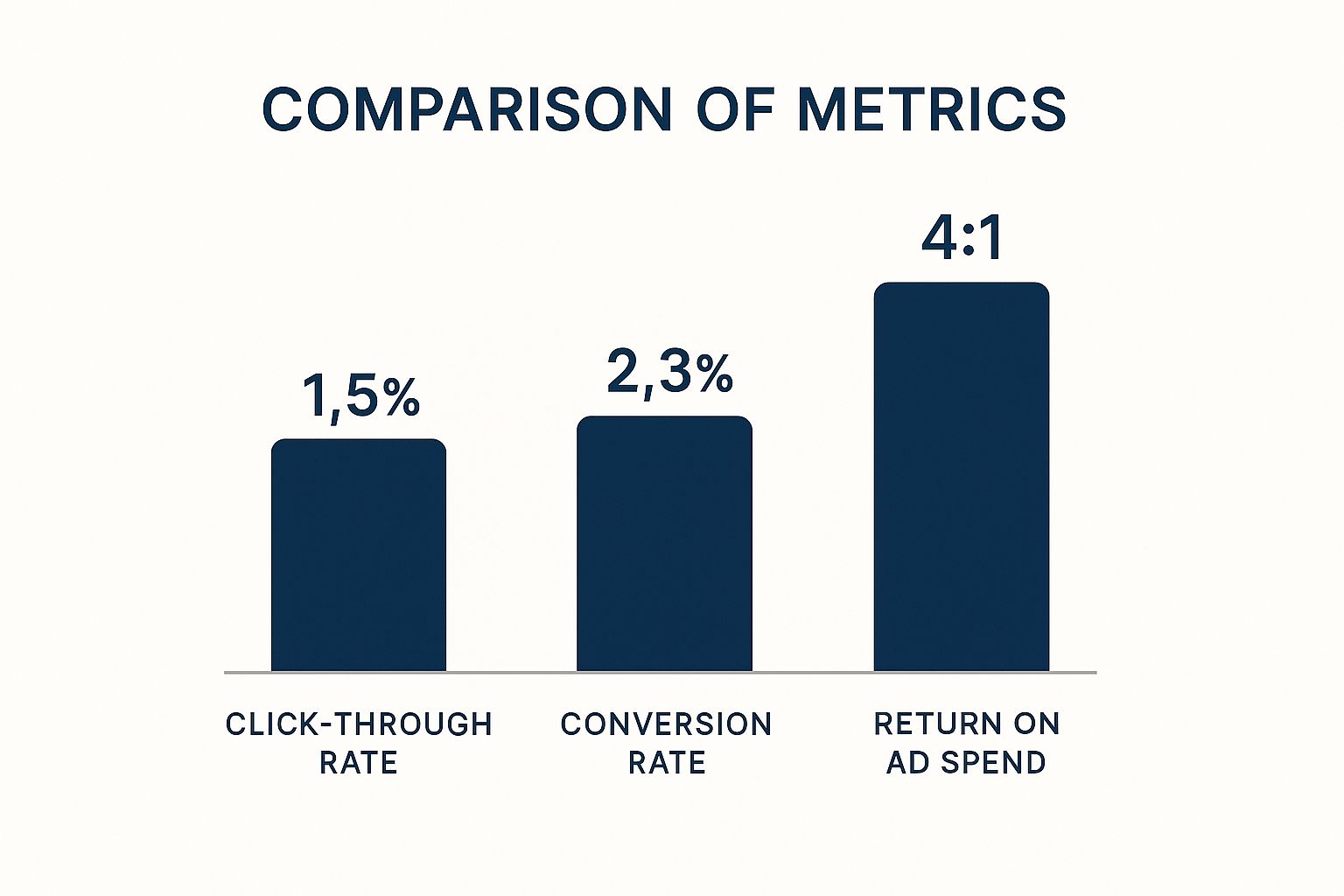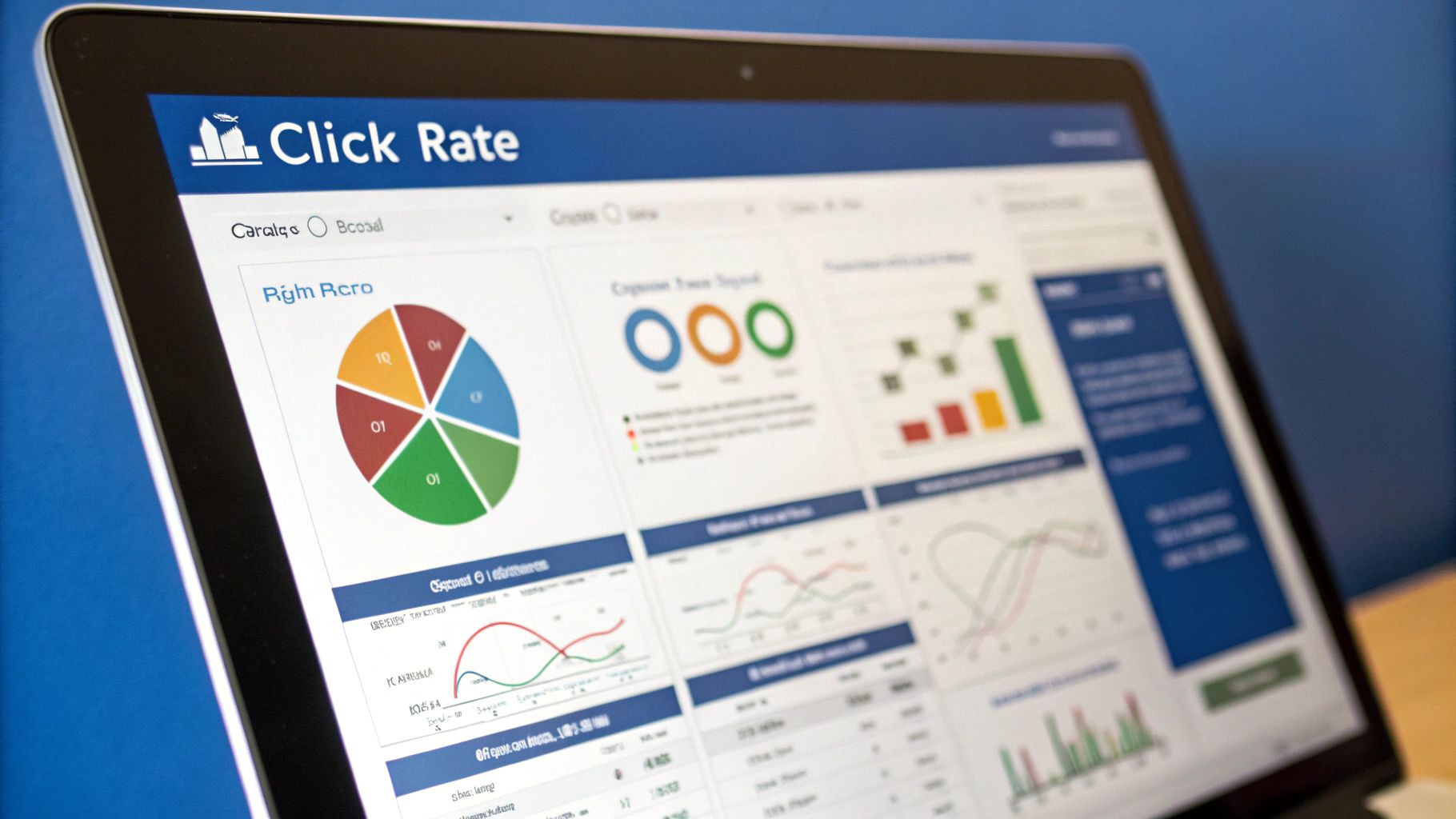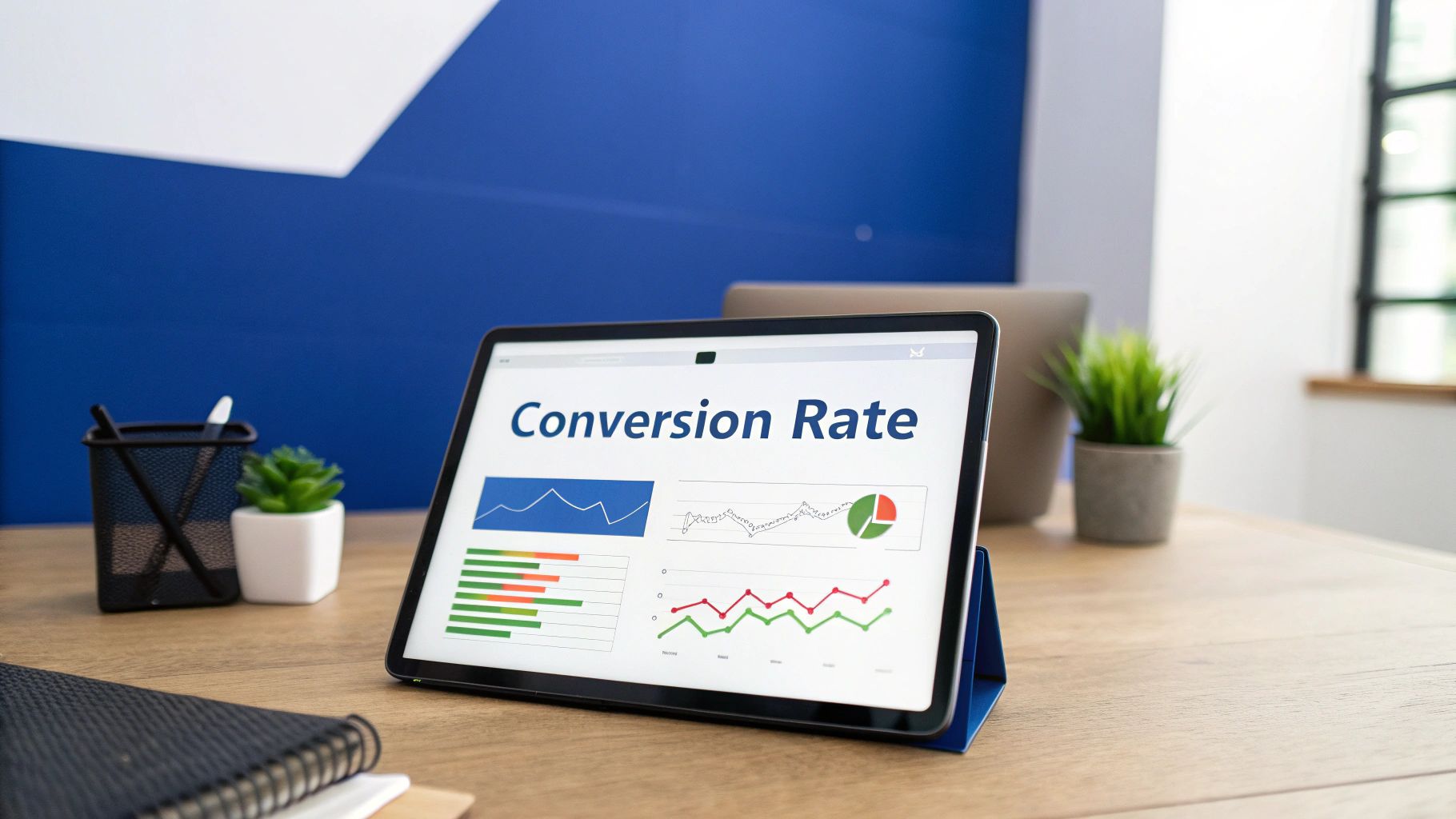Unlocking Profitability with Advertising Performance Metrics
Master the advertising performance metrics that drive real profit and growth. Learn how to move beyond vanity stats to build a scalable eCommerce brand.

When we talk about advertising performance metrics, we're not just discussing clicks and impressions. Those are table stakes. True performance analysis digs into the metrics that reveal how effective—and, more importantly, how profitable—your ad campaigns are in driving sustainable scale.
Metrics like Return on Ad Spend (ROAS) and Total Advertising Cost of Sale (TACOS) tell the real story. They connect your ad budget directly to revenue, profitability, and the long-term, defensible growth of your brand.
Beyond Clicks: Measuring What Truly Drives Profit
For too long, eCommerce brands chased vanity metrics. A high click-through rate or a low cost-per-click looks impressive on a report, but those numbers alone don’t pay the bills. This outdated thinking traps brands in a spend-and-hope cycle, burning cash on traffic without a clear line to profitability.
Think of it this way: getting a lot of people to walk into your store is great (that's your clicks), but what really matters is how many of them buy something, and how that impacts your bottom line.
The image below paints a clear picture of this journey from simple engagement to real performance.

As you can see, many people might click an ad, but only a fraction convert. The ultimate test is how much revenue those sales generate for every dollar you spent—that’s your ROAS.
The Shift from Vanity Metrics to Performance Metrics
To truly grasp this shift, let's contrast the old and new ways of thinking. Vanity metrics show surface-level activity, while performance metrics are directly tied to profitability and business strategy.
| Vanity Metric (What It Shows) | Performance Metric (What It Drives) | Strategic Business Question Answered |
|---|---|---|
| Clicks & Impressions (Visibility) | Conversion Rate (Customer Action) | Is my creative and landing page compelling enough to convert interest into a sale? |
| Cost-per-Click (Efficiency) | Customer Acquisition Cost (Profitability) | Are we acquiring new customers at a cost that our margins can sustain? |
| Click-Through Rate (Engagement) | Return on Ad Spend (ROAS) (Direct ROI) | For every dollar I spend on this campaign, am I generating profitable revenue? |
| Ad Spend (Budget Burn) | Total ACoS (TACOS) (Overall Health) | Is my advertising investment building brand equity and reducing my reliance on paid media over time? |
By focusing on the right-hand column, you move from just running ads to making strategic investments that grow your entire business.
PPC as a Lever for Organic Growth
The most sophisticated eCommerce leaders view paid advertising as more than just a sales channel. They see it as a powerful lever for building sustainable, long-term growth.
When executed correctly, pay-per-click (PPC) campaigns create a powerful flywheel effect. Paid ads drive initial sales velocity, which in turn boosts organic rankings, builds brand authority, and captures greater market share. This is especially true on a competitive marketplace like Amazon, where the A9 algorithm heavily rewards products with strong sales history—a velocity that ads are uniquely positioned to create.
This modern approach means analyzing a connected set of advertising performance metrics to answer critical business questions:
- Are we acquiring customers profitably?
- Is our ad spend building long-term brand equity and customer loyalty?
- Are we becoming less dependent on paid advertising as our organic presence strengthens?
At Headline, our philosophy is simple: Advertising is an investment in your brand's future, not just an expense on a P&L. By focusing on metrics that measure total business impact, we help brands build a defensible moat and achieve scalable profitability.
In this guide, we'll walk you through the essential metrics you need to master, moving from foundational KPIs to the advanced analytics that separate market leaders from the pack.
Mastering the Foundational Four Ad Metrics

To build a profitable advertising machine, you must speak its language fluently. Real clarity comes from understanding the story told by four core numbers. These aren't just data points—they're diagnostic tools, revealing the health and efficiency of your campaigns from the first click to the final sale.
Think of them as a chain reaction. Each metric answers a key question about your customer's journey and flows into the next, painting a full picture of your campaign's performance and financial return.
The Customer Journey in Four Metrics
Let's walk through how each of these metrics gives you a different piece of the puzzle.
Click-Through Rate (CTR): This is your first test: does your ad resonate? A high CTR signals that your creative, copy, and targeting are aligned, compelling your audience to learn more. A low CTR is an early warning that your ad is getting lost in the noise or reaching the wrong people.
Cost-Per-Click (CPC): This is the price you pay for a potential customer's attention. While a low CPC seems attractive, a higher CPC for a high-intent audience is often a smarter investment. The strategic goal is to balance this cost against the ultimate value each click delivers.
This balance is more critical than ever. While search ad costs have risen for five consecutive years, smart strategy is winning out. New research for 2025 shows 65% of industries actually improved their conversion rates, proving that targeting the right, high-intent audience is far more effective than chasing cheap clicks. You can explore more of these 2025 Google Ads benchmarks to see for yourself.
From Clicks to Profitability
Once you've earned that click, the focus shifts from cost to conversion.
Conversion Rate (CVR): This is where the rubber meets the road. Did your offer deliver? A strong CVR indicates that your landing page experience fulfills the promise made in your ad. A high CTR paired with a low CVR signals a "leaky bucket"—you're paying to bring people in, but your product page isn't closing the deal.
Return on Ad Spend (ROAS): This is the ultimate bottom-line metric for your ads. It tells you exactly how much revenue you generated for every single dollar you spent. ROAS directly connects your ad campaigns to sales, answering the big question: "Is this thing actually making us money?"
While ROAS is essential for judging a campaign’s health, it isn’t the whole story. A truly strategic approach also looks at how your ads contribute to total business growth. This is where a metric like Marketing Efficiency Ratio (MER) comes in. You can learn more about how to measure your overall marketing effectiveness in our guide.
By monitoring these four metrics in concert, you can move beyond surface-level analysis. You gain a clear, actionable framework for diagnosing problems, capitalizing on successes, and ensuring every dollar spent drives real, profitable growth.
Using ACOS and TACOS to Win on Amazon

While the core metrics apply everywhere, winning on a fiercely competitive marketplace like Amazon requires mastering its specific language. The two most vital terms are ACOS (Advertising Cost of Sale) and TACOS (Total Advertising Cost of Sale).
Understanding the difference is what separates sellers who spin their wheels from those who build a sustainable, profitable business.
Think of ACOS as a spotlight. It illuminates a single campaign's efficiency. The formula is simple: (Ad Spend / Ad Revenue) x 100. A low ACOS means you're getting a great return on that specific ad.
But focusing only on ACOS is like driving while staring at your speedometer. You know your immediate speed, but you have no idea if you're heading in the right direction.
TACOS: Your Strategic North Star
This is where TACOS changes the game. It measures your ad spend against your total revenue—including sales from ads and organic sales. The formula is (Ad Spend / Total Revenue) x 100. This single metric provides a true picture of your advertising's impact on your overall business health on Amazon.
TACOS answers the million-dollar question: Is my advertising making my brand stronger and less dependent on paid ads over time?
A decreasing TACOS—even if ACOS holds steady or temporarily increases—is a powerful indicator of success. It demonstrates that your ads are creating a flywheel effect, boosting organic rank and driving sales you don't have to pay for directly.
The real goal isn't just a low ACOS. It's a low and decreasing TACOS. That's the definitive proof that your ad investment is building long-term brand equity and organic visibility—the key to scaling profitably on Amazon.
When a Higher ACOS Actually Drives a Lower TACOS
This might sound counterintuitive, so let's walk through a real-world Amazon example. Imagine you're launching a new product.
Month 1 (Launch): You spend $2,000 on aggressive ads, generating $10,000 in ad-driven sales. Your total sales for the month, including a few organic purchases, hit $15,000.
- ACOS: ($2,000 / $10,000) = 20%
- TACOS: ($2,000 / $15,000) = 13.3%
Month 6 (Scaling): The product is gaining traction. To dominate the category, you increase ad spend to $5,000, which now generates $20,000 in direct ad sales. But here’s the magic: fueled by earlier ad-driven velocity, your organic rank has soared, and total sales have jumped to $50,000.
- ACOS: ($5,000 / $20,000) = 25% (It went up!)
- TACOS: ($5,000 / $50,000) = 10% (But this went down!)
In this scenario, allowing ACOS to rise was a brilliant strategic move. The increased investment fueled a massive lift in organic sales, building a much healthier and more profitable business—which the lower TACOS clearly validates. This is how top brands think: they use ads as a lever for total growth, not just as a direct sales tool.
Advanced Metrics for Sustainable eCommerce Scale
If you're serious about building a durable eCommerce business, you must look beyond day-to-day campaign performance. While metrics like ACOS and ROAS are crucial for measuring immediate results, the two numbers that predict long-term financial health are Customer Acquisition Cost (CAC) and Lifetime Value (LTV). They tell you if your growth engine is truly sustainable.
Think of CAC as the total price you pay to acquire one new customer. It’s not just ad spend. It’s all your sales and marketing costs over a period, divided by the number of new customers acquired. Viewing it this way transforms CAC from a mere expense into a strategic investment in a future revenue stream.
The Power Couple: LTV and CAC
Knowing your acquisition cost is only half the equation. The other half is LTV: the total profit you can realistically expect from that customer over their entire relationship with your brand.
This is where strategic thinking creates a competitive advantage. A customer who buys a $50 product might seem less valuable than one who buys a $100 product. But what if that first customer returns four more times over the next two years? Their LTV skyrockets, making them a far more valuable asset.
The relationship between these two metrics tells the true story of your business's health.
The LTV:CAC ratio is the ultimate health check for your business. It answers a simple but critical question: For every dollar I spend to acquire a customer, how much value do I get back over time? A healthy business model ensures the value you gain far exceeds the cost of acquisition.
Using the LTV:CAC Ratio to Outmaneuver Competitors
A strong LTV:CAC ratio is your green light to scale advertising aggressively—and profitably. The industry benchmark for a healthy ratio is 3:1, meaning you generate $3 in lifetime value for every $1 spent on acquisition. If your ratio is below 1:1, you’re effectively paying to lose money.
Consider this classic Amazon scenario:
- Brand A has an LTV of $90 and maintains a strict CAC of $30 (a solid 3:1 ratio). They are profitable but must bid cautiously.
- Brand B has invested in customer loyalty and subscriptions, boosting their LTV to $200. Aiming for the same 3:1 ratio, they can comfortably spend up to $66 to acquire a new customer.
Because Brand B understands its customers are worth more long-term, it can afford a higher CAC. This allows them to outbid Brand A on critical keywords, dominate top-of-search placements, and accelerate market share capture. This is what a performance-first mindset looks like in action—using deeper advertising performance metrics to fuel sustainable growth.
For any brand on a competitive platform like Amazon, mastering this balance is paramount. To get a more detailed look at how these strategies work on the marketplace, check out our guide to Amazon advertising optimization.
How to Measure Performance Across Ad Channels
Not all ad channels are created equal, and they can't be measured with the same yardstick. A 1% click-through rate might be a huge win on one platform but a total failure on another. The key is to understand user intent—why a person is on that channel in the first place.
Consider the user's mindset. Someone on Google is on a mission. They're typing "noise-canceling headphones for air travel" because they have a specific problem and are actively seeking a solution. Their purchase intent is high.
Now, picture someone scrolling through their TikTok feed. They're there to be entertained and discover new content. Your ad must first interrupt their flow, then capture their attention, and finally persuade them to care about your product. It's a completely different context.
This fundamental difference in user intent should shape your expectations for core advertising performance metrics.
Context Is Everything for Your KPIs
Applying a one-size-fits-all benchmark to your marketing is a recipe for wasted spend and missed opportunities. Here’s how intent changes the game across different channels:
- High-Intent Channels (e.g., Google Search): Expect higher click-through and conversion rates. People are already looking for what you sell. Your job is to prove you're the best choice.
- Discovery Channels (e.g., TikTok, Instagram): Expect lower direct CTRs and conversions. Success here is measured by brand awareness and engagement. You're planting a seed that will hopefully lead to a future sale.
- Re-engagement Channels (e.g., Email, Retargeting Ads): This is where you can see your highest conversion rates. You’re speaking to a warm audience that already knows you; the goal is to provide the final nudge toward purchase.
The smartest strategies don't chase a uniform CTR across all channels. Instead, they aim for a high CTR on Google and high engagement rates on social media, recognizing that each plays a distinct role in guiding a customer toward a purchase.
This isn't just theory; it's reflected in major advertising shifts. Digital advertising now commands over 63% of global budgets, with social media ad spend alone jumping 140% in the last five years as brands follow consumer attention. Even an established channel like email proves this principle: triggered emails see an 88% higher conversion rate than generic blasts because they reach customers at moments of high intent. You can explore more of these evolving advertising statistics to see how much context matters.
Setting Realistic Cross-Channel Goals
To build an effective advertising strategy, you must evaluate each platform's performance within its own context. For Amazon sellers, this means looking beyond Sponsored Products ads to understand how the entire ecosystem works together. Smart budget allocation and long-term growth are built on accurate, channel-specific reporting. For a closer look at this, check out our guide to mastering Amazon advertising reporting.
By understanding the unique role of each channel, you can set smarter goals, allocate budget more effectively, and build a cohesive strategy where every dollar works as hard as possible.
The Only Metric That Truly Matters

We’ve dissected numerous metrics, from the foundational CTR to the strategic TACOS. Each provides a critical lens for viewing performance, but if you had to discard all but one, which would you keep?
It’s not ROAS, LTV, or any other acronym. It’s profit.
Every single one of the advertising performance metrics we've covered is simply a clue on the trail to profit. They are diagnostic tools used to understand why you’re making money—or why you aren’t.
After all, a high conversion rate is meaningless if your customer acquisition cost creates a loss on every sale. A fantastic ROAS on a single campaign means little if your total ad spend is draining your cash flow and cannibalizing organic sales.
From Campaign Manager to Profit Engineer
The most significant leap forward for any eCommerce leader is the shift from thinking like a campaign manager to acting like a profit engineer. This is a fundamental change in perspective where advertising ceases to be an expense and becomes the most direct lever you have to grow your bottom line.
Consider the scale of the landscape. Global ad spend is projected to hit $1.15 trillion in 2025, with a massive portion flowing into digital channels where every action is trackable. We see impressive stats everywhere—Google ads hitting a 5.07% average CTR, or videos boosting conversions by up to 70%. These numbers are exciting, but they are only valuable if they translate to real, take-home profit. You can find more insights into the advertising industry to grasp the scale of the opportunity.
Adopting this profit-first mindset changes the questions you ask.
- Instead of, "What's my ACOS?" you ask, "Is my total ad spend driving down my TACOS and increasing my net profit?"
- Instead of, "How can I get a cheaper CPC?" you ask, "What am I willing to pay to acquire a new customer whose LTV I know justifies the investment?"
Your Final Takeaway The goal was never just to run good ad campaigns. It's to build a profitable growth engine for your business. When you truly understand these advertising performance metrics, you have the roadmap to make smarter decisions—the kind that ensure every dollar you spend is an investment in sustainable, profitable growth. That’s how you win the game.
Your Top Questions, Answered
Alright, we’ve walked through the key advertising metrics that drive a modern eCommerce business. Now, let’s get down to brass tacks and answer the practical questions we hear most often from brand leaders trying to put these theories into action.
What’s a Good ROAS for My eCommerce Brand?
This is the million-dollar question, but the honest answer is: it depends. There’s no universal "good" number.
While you'll often hear a 4:1 ratio ($4 back for every $1 spent) thrown around as a benchmark, that figure is completely meaningless without knowing your profit margins. A brand selling luxury watches with a high margin could be wildly profitable at a 3:1 ROAS. On the other hand, a business selling low-margin consumables might need an 8:1 ROAS or higher just to see a dime of profit.
The only way to find your magic number is to calculate your break-even ROAS. Figure out your cost of goods and all associated variable costs. Anything you make above that break-even point is profit in your pocket. Always remember, the real goal isn't just a high ROAS percentage; it's maximizing your total profit dollars.
How Can I Actually Improve My TACOS on Amazon?
Lowering your Total Advertising Cost of Sale (TACOS) is all about making your ads more effective at driving your entire business forward, not just the sales they're directly credited for. A falling TACOS is the ultimate proof that your brand is gaining momentum and becoming less reliant on paid ads to grow.
So, how do you do it?
- Target for Rank: Don't just bid on keywords with the lowest ACOS. Strategically bid on terms where you want to improve your organic ranking. The short-term ad cost is an investment in long-term, free organic sales.
- Obsess Over Conversion: Your ads can bring people to the door, but your product page has to close the deal. Make sure your listings are fully optimized with stellar images, persuasive copy, and a healthy number of positive reviews. A great product page makes every ad dollar work harder.
- Jumpstart New Products: When you launch a new product, advertising is your best friend. Use it aggressively to generate that crucial initial sales velocity, which signals to Amazon's A9 algorithm that your product is a winner worth showing to more shoppers.
Should I Focus on CTR or Conversion Rate First?
Start with your Conversion Rate (CVR). Every single time.
Think of it this way: a high Click-Through Rate (CTR) with a low CVR is like spending a fortune on a flashy billboard to direct tons of people to a store with broken doors and empty shelves. You’re paying for clicks that don't turn into customers, which is the fastest way to drain your ad budget. It tells you there's a major disconnect between what your ad promises and what your product page delivers.
Before you try to get more people in the door, fix the store. Optimize your product page to convert the traffic you’re already getting. Once your CVR is strong, then you can focus on improving your CTR by testing new ad creative and copy to attract more high-intent shoppers.
Ready to stop guessing and start engineering profitable growth? The experts at Headline Marketing Agency use a data-first approach to turn advertising into your most powerful lever for sustainable scale on Amazon. Learn how we build profit-focused strategies that win.
Ready to Transform Your Amazon PPC Performance?
Get a comprehensive audit of your Amazon PPC campaigns and discover untapped growth opportunities.